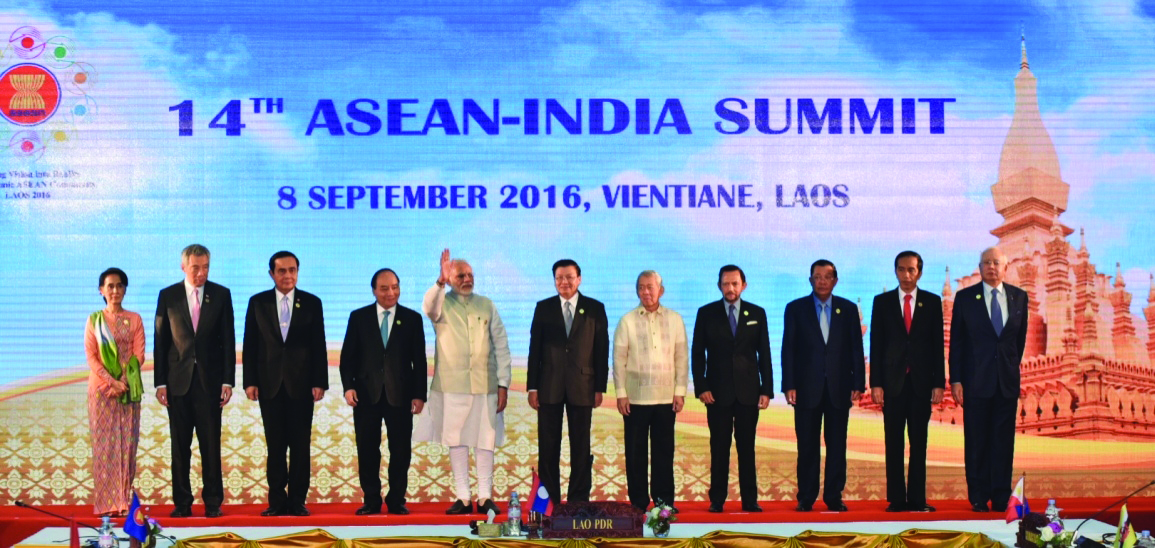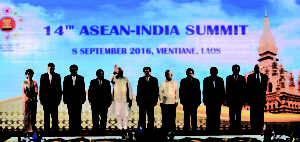

PM Narendra Modi attends 14th ASEAN – India summit at Vientiane, Laos Photo: www.narendramodi.in
That 10 leaders of the Association of South East Asian Nations (ASEAN) occupied ringside seats at India’s Republic Day Jan. 26, was a symbolic testament to Prime Minister Narendra Modi’s ‘Act East’ policy. But it also bore fruit at a summit where the two parties signed an agreement outlined the relationship in substantive terms.
The optics of the presidents, prime ministers and a Sultan at the nationally televised Republic Day, marks a “big step forward” for India’s Looking East policy, and the first time South East Asia was so prominently displayed in India, says Sadanand Dhume, resident fellow at the American Enterprise Institute. “It’s a gift the Modi administration has of using spectacle in furthering India’s foreign policy.”
The invitation to the 10 ASEAN leaders signals a relationship in which ASEAN and India are willing to invest heavily, both politically and diplomatically, according to Anubhav Gupta, assistant director with the Asia Society Policy Institute in New York. A concrete agreement signed by ASEAN and India at a summit held the day before Republic Day is proof of that.
The Delhi Declaration of the ASEAN-India Commemorative Summit to mark the 25th Anniversary of ASEAN-India Dialogue Relations, held Jan. 25, in New Delhi, was on the theme ‘Shared Values, Common Destiny.’
Noting the strong “cross-cultural exchanges and civilisational linkages between Southeast Asia and India over several millennia,” the parties pledged to “Further strengthen and deepen the ASEAN-India Strategic Partnership for mutual benefit, across the whole spectrum of political-security, economic, socio-cultural and development cooperation.” The parties committed to continue working “closely together on common regional and international security issues of mutual concern and ensure an open, transparent, inclusive and rules-based regional architecture.” They reaffirmed the “importance of maintaining and promoting peace, stability, maritime safety and security, freedom of navigation and overflight in the region,” and peaceful resolution of disputes, according to international laws.
The agreement also sought to “deepen cooperation in combating terrorism in all its forms” and countering it through information sharing, law enforcement cooperation and capacity building. (See text of Agreement).
More than a thousand years of history between India and the ASEAN countries, experts agree, is being seemingly infused with new life, geared toward economic, strategic, national security, environment, and connectivity, in this modern and technological age.
“ASEAN is central to India’s ‘Act East’ Policy. And, our ties are a source of balance and harmony in the region,” Modi said on Sept. 8, 2016, noting that the engagement was driven not just by shared civilizational heritage, but “also driven by our common strategic priorities of securing our societies and bringing peace, stability and prosperity to the region.”
His pro-active approach to ASEAN, maturing it from the ‘Look East’ emphasis to ‘Act East’ was articulated just months after Modi took office, at the 12th ASEAN India Summit in Nay Pyi Taw, Myanmar’s new capital, in November, 2014.
Walking The Talk
While India will not be a member of ASEAN, it is trying to build relations at the institutional level and the individual country level, Dhume notes.
By making the ASEAN policy pro-active, New Delhi stands to reap benefits way beyond the more incremental pace of the past, Gupta said, adding, “The strategy itself is not new but has a new invigorated focus.” For instance, Modi has traveled far more extensively in the region than Indian leaders before him, and with more clearly targeted economic objectives.
“Even though India has for a long time talked about it (engaging Southeast Asia), now it is finally walking the talk,” Gupta said.
India-ASEAN trade and investment relations have been growing steadily, with ASEAN being India’s fourth largest trading partner. Bilateral trade stood at approximately US$ 76.53 billion in 2014-15.
India’s imports from ASEAN are higher by several billions than its exports to the region in recent years, which reality may explain Modi’s focus on the economics of the relationship.
According to an analysis by Pyaralal Raghavan in the Times of India, India’s exports to ASEAN were up significantly in the initial years — $18.1 billion in 2009-10 to $ 33.1 billion in 2013-14. But they fell to $ 25.1 billion in 2015-16. The share of Indian exports to ASEAN rose to as high as 16.9% by 2012-13, but dropped to it has 9.5% by 2015-16. Foreign Direct Investment has also not been in India’s favor, MEA figures show.
Gupta recommends India be even more engaged economically and promotes APEC, the Asia Pacific Economic Cooperation, grouping as one of the solutions. The 21-member APEC stretches all the way from Southeast Asia to Peru, taking in seven ASEAN members and major economies including Australia, China, Russia, Japan, Canada and the United States.
Dhume on the other hand, contends APEC is a complex relationship and the more appropriate organization where India can get results is RCEP or the Regional Comprehensive Economic Partnership of which India is a member. The RCEP also includes all the ASEAN members and Australia, China, Japan, South Korea and New Zealand and aims at equalizing economic disparities and broadening and deepening engagement in the economic development of the region, the RCEP website states.
Energizing Diplomacy
Dhume lauded the policy vigor adopted by New Delhi in more recent years.
“Looking toward East Asia is more an example of how the Modi administration has energized Indian diplomacy. It is a symbol of greater ambition. This is a question of trying to do more in this region, not that the West has become less important,” says Dhume.
Modi has ratcheted up this relationship even as President Donald Trump put India front and center in the Asian power equation, renaming the region “Indo-Pacific” from the older “Asia-Pacific” in Washington’s strategy. Washington now wants to develop a quadrilateral alliance in the region with India, Australia and Japan.
A stronger relationship with the U.S. gives India a strong hand to play with ASEAN, because Washington remains the dominant power in Asia, and ASEAN looks to the U.S. for direction.
“If Washington indicates a larger role for India, it strengthens India’s hand,” Dhume opines.
Gupta reverses the equation. India’s current assertiveness vis-a-vis ASEAN, and the strong positions it has taken even in areas where personal interests are not so directly connected, is a result of its own strong economic growth, Gupta contends.
“India’s more confident and engaged outlook and strong economy has led other countries (including the U.S.), to include it in their strategic equation,” contends Gupta, for example Washington’s “Indo Pacific” frame of reference “suddenly making India the anchor rather than the peripheral country in the region.”
Yet, while India has begun the process, it needs to play a more active role in Asia and South East Asia, and express its own positions and principles as it has begun doing on wanting “open” seas and the rule of law to govern the seas, experts say.
All this is transpiring in the backdrop of increasingly aggressive postures adopted by the Chinese leadership in the region, which worry nations of ASEAN and others.
Despite this posturing both in the oceans and on India’s land border, New Delhi’s strong position on open oceans and the rule of law, harkens to an independence and strength, and an awareness that appeasing China seldom assures a positive outcome, Gupta notes.
India’s 25-year relationship with ASEAN, an organization that was founded in 1967, could be counted among its foreign policy successes. Based on concrete five-year “Plan(s) of Action” under the rubric of “Partnership for Peace, Progress and Shared Prosperity,” the latest being the 2016-2020 plan, the relationship covers political and security concerns, economic, socio-cultural cooperation, connectivity and a host of other areas.
India’s relationship with ASEAN dates back to 1992, growing from merely a “sectoral” dialogue to a “full” dialogue partnership in December 1995. The relationship was further elevated with the convening of the ASEAN-India Summit in 2002 in Phnom Penh, Cambodia, from when the ASEAN-India Summit has been held annually. “All these took place in a decade, which clearly signifies the importance of the dialogue partnership to ASEAN and India and the progress made in the cooperation,” the organization says on its website.
At the 13th ASEAN-India Summit held in Kuala Lumpur in November 2015, the ASEAN leaders welcomed Modi’s “Act East Policy” and noted the initiatives potentially complemented their own efforts.
“Economics is more important than culture for these young economies – looking to build jobs, and interested in trade and manufacturing,” said Sadanand Dhume, resident fellow at the American Enterprise Institute.
Modi mirrored the goals expressed by ASEAN leaders — economics was his focus as well.
“The substance of our strategic partnership covers all three major segments of ASEAN activities-security, economic and socio-cultural. And, the ASEAN India Plan of Action for the period 2016-2020 has served us well in fulfilling our objectives. We have already implemented 54 out of 130 activities identified in the Plan of Action,” Modi said in his 2016 address to ASEAN leaders.
“Enhancing connectivity in all its dimensions- physical, digital, economic, institutional and cultural-is at the heart of India’s strategic partnership with ASEAN. And, readiness to link our economic success, and share development experiences with ASEAN nations, especially the CLMV (Cambodia, Laos, Myanmar, Vietnam) countries, drives our engagement,” Modi asserted.

Ela Dutt
| Editor, Parikh Worldwide Media
Leave Comments